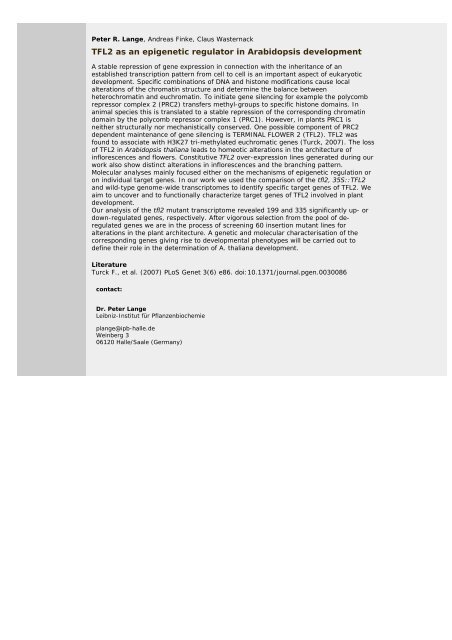Abstracts (poster) - Wissenschaft Online
Abstracts (poster) - Wissenschaft Online
Abstracts (poster) - Wissenschaft Online
Create successful ePaper yourself
Turn your PDF publications into a flip-book with our unique Google optimized e-Paper software.
Peter R. Lange, Andreas Finke, Claus Wasternack<br />
TFL2 as an epigenetic regulator in Arabidopsis development<br />
A stable repression of gene expression in connection with the inheritance of an<br />
established transcription pattern from cell to cell is an important aspect of eukaryotic<br />
development. Specific combinations of DNA and histone modifications cause local<br />
alterations of the chromatin structure and determine the balance between<br />
heterochromatin and euchromatin. To initiate gene silencing for example the polycomb<br />
repressor complex 2 (PRC2) transfers methyl-groups to specific histone domains. In<br />
animal species this is translated to a stable repression of the corresponding chromatin<br />
domain by the polycomb repressor complex 1 (PRC1). However, in plants PRC1 is<br />
neither structurally nor mechanistically conserved. One possible component of PRC2<br />
dependent maintenance of gene silencing is TERMINAL FLOWER 2 (TFL2). TFL2 was<br />
found to associate with H3K27 tri-methylated euchromatic genes (Turck, 2007). The loss<br />
of TFL2 in Arabidopsis thaliana leads to homeotic alterations in the architecture of<br />
inflorescences and flowers. Constitutive TFL2 over-expression lines generated during our<br />
work also show distinct alterations in inflorescences and the branching pattern.<br />
Molecular analyses mainly focused either on the mechanisms of epigenetic regulation or<br />
on individual target genes. In our work we used the comparison of the tfl2, 35S::TFL2<br />
and wild-type genome-wide transcriptomes to identify specific target genes of TFL2. We<br />
aim to uncover and to functionally characterize target genes of TFL2 involved in plant<br />
development.<br />
Our analysis of the tfl2 mutant transcriptome revealed 199 and 335 significantly up- or<br />
down-regulated genes, respectively. After vigorous selection from the pool of deregulated<br />
genes we are in the process of screening 60 insertion mutant lines for<br />
alterations in the plant architecture. A genetic and molecular characterisation of the<br />
corresponding genes giving rise to developmental phenotypes will be carried out to<br />
define their role in the determination of A. thaliana development.<br />
Literature<br />
Turck F., et al. (2007) PLoS Genet 3(6) e86. doi:10.1371/journal.pgen.0030086<br />
contact:<br />
Dr. Peter Lange<br />
Leibniz-Institut für Pflanzenbiochemie<br />
plange@ipb-halle.de<br />
Weinberg 3<br />
06120 Halle/Saale (Germany)

















